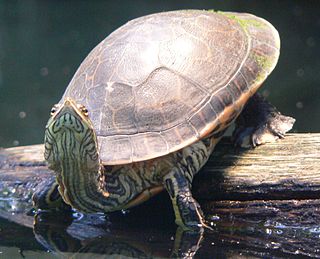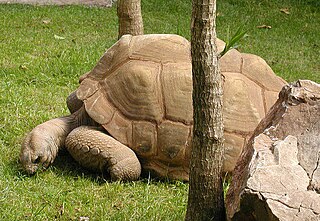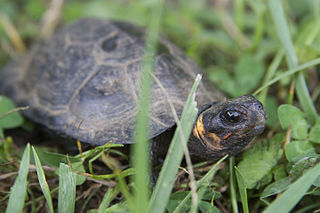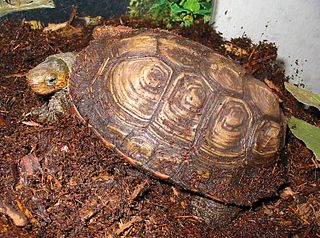
Auks or alcids are a group of birds of the family Alcidae in the order Charadriiformes. The alcid family includes the murres, guillemots, auklets, puffins, and murrelets. The family contains 25 extant or recently extinct species that are divided into 11 genera. Auks are found throughout the Northern Hemisphere.

Emydidae is a family of testudines (turtles) that includes close to 50 species in 10 genera. Members of this family are commonly called terrapins, pond turtles, or marsh turtles. Several species of Asian box turtles were formerly classified in the family; however, revised taxonomy has separated them to a different family (Geoemydidae). As currently defined, the Emydidae are entirely a Western Hemisphere family, with the exception of two species of pond turtle.

Chelidae is one of three living families of the turtle suborder Pleurodira, and are commonly called Austro-South American side-neck turtles. The family is distributed in Australia, New Guinea, parts of Indonesia, and throughout most of South America. It is a large family of turtles with a significant fossil history dating back to the Cretaceous. The family is entirely Gondwanan in origin, with no members found outside Gondwana, either in the present day or as a fossil.

Podocnemididae is a family of pleurodire (side-necked) turtles, once widely distributed. Most of its 41 genera and 57 species are now extinct. Seven of its eight surviving species are native to South America: the genus Peltocephalus, with two species, only one of which is extant ; and the genus Podocnemis, with six living species of South American side-necked river turtles and four extinct. There is also one genus native to Madagascar: Erymnochelys, the Madagascan big-headed turtle, whose single species E. madagascariensis.

Trachemys is a genus of turtles belonging to the family Emydidae. Members of this genus are native to the Americas, ranging from the Midwestern United States south to northern Argentina, but one subspecies, the red-eared slider, has been introduced worldwide. Species under this genus are commonly referred to as sliders.

The spotted turtle, the only species of the genus Clemmys, is a small, semi-aquatic turtle that reaches a carapace length of 8–12 cm (3.1–4.7 in) upon adulthood. Their broad, smooth, low dark-colored upper shell, or carapace, ranges in its exact colour from black to a bluish black with a number of tiny yellow round spots. The spotting patterning extends from the head, to the neck and out onto the limbs. Sexually mature males have a concave plastron and a long, thick tail. By contrast, sexually mature females possess a flat plastron and have a tail that is noticeably shorter and thinner than that of mature males. Mature males also have a dark iris and face; females typically have a yellow or orange iris and a similarly coloured face that is distinctly lighter than the males'. Juveniles appear female-like in this regard, and at maturity males begin to develop darker features.

Pseudemys is a genus of large, herbivorous, freshwater turtles of the eastern United States and adjacent northeast Mexico. They are often referred to as cooters, which stems from kuta, the word for turtle in the Bambara and Malinké languages, brought to America by enslaved people from Africa.

Deirochelys is a genus of freshwater turtle in the family Emydidae, the pond and marsh turtles. It contains one extant species, the chicken turtle, which is native to the southeastern United States. A second extinct member, Deirochelys carri, is known from a fossil found in Alachua County, Florida. The genus was first described by Louis Agassiz in 1857, and its name is derived from the Ancient Greek words for "neck" (deirḗ) and "tortoise" (khélūs), referring to the particularly long necks of these turtles.

Chrysemys is a genus of turtles in the family Emydidae. They are found throughout most of North America.

The Cryptodira are a suborder of Testudines that includes most living tortoises and turtles. Cryptodira differ from Pleurodira in that they lower their necks and pull the heads straight back into the shells, instead of folding their necks sideways along the body under the shells' marginals. They include among their species freshwater turtles, snapping turtles, tortoises, softshell turtles, and sea turtles.

Testudo, the Mediterranean tortoises, are a genus of tortoises found in North Africa, Western Asia, and Europe. Several species are under threat in the wild, mainly from habitat destruction.

Asian box turtles are turtles of the genus Cuora in the family Geoemydidae. About 12 extant species are recognized. The keeled box turtle is often included in this genus, or separated in the monotypic genus Pyxidea. Genus Cuora is distributed from China to Indonesia and the Philippines, throughout mainland Southeast Asia, and into northern India and Bhutan.

The bog turtle is a critically endangered species of semiaquatic turtle in the family Emydidae. The species is endemic to the eastern United States. It was first scientifically described in 1801 after an 18th-century survey of Pennsylvania. The smallest North American turtle, its carapace measures about 10 centimeters (4 in) long when fully grown. Although the bog turtle is similar in appearance to the painted or spotted turtles, its closest relative is actually the somewhat larger wood turtle. The bog turtle can be found from Vermont in the north, south to Georgia, and west to Pennsylvania. Diurnal and secretive, it spends most of its time buried in mud and – during the winter months – in hibernation. The bog turtle is omnivorous, feeding mainly on small invertebrates. The bog turtle is the state reptile of New Jersey.

Trionychia is a superfamily of turtles which encompasses the species that are commonly referred to as softshelled turtles as well as some others. The group contains two families, Carettochelyidae, which has only one living species, the pig-nosed turtle native to New Guinea and Northern Australia, and Trionychidae, the softshelled turtles, containing numerous species native to Asia, North America and Africa. These families likely diverged during the late Jurassic. The oldest known stem-trionychian is Sinaspideretes from the Late Jurassic of China.

Testudinoidea is a superfamily within the suborder Cryptodira of the order Testudines. It includes the pond turtles, Asian turtles, the monotypic big-headed turtle, and the tortoises.

Rhinoclemmys is a genus of turtles in the family Geoemydidae, the only genus in the subfamily Rhinoclemmydinae. Member species of the genus are commonly known as the Neotropical wood turtles and are the only geoemydids known from the Americas. As such, they have adapted to a wide range of habitats, which is reflected in the species' common names.

Glyptemys is a genus of turtles in the family Emydidae. It comprises two species, the bog turtle and wood turtle, both of which are endemic to North America. Until 2001, these turtles were considered members of the genus Clemmys, which currently has one member, the spotted turtle.

Hesperotestudo is an extinct genus of tortoise native to North and Central America from the Early Miocene to the Late Pleistocene. Species of Hesperotestudo varied widely in size, with a large undescribed specimen from the Late Pleistocene of El Salvador reaching

Chelonoidis is a genus of turtles in the tortoise family erected by Leopold Fitzinger in 1835. They are found in South America and the Galápagos Islands, and formerly had a wide distribution in the West Indies.

Titanochelon is an extinct genus of giant tortoises known from the Early Miocene to the beginning of the Pleistocene in Europe, extending from the Iberian Peninsula to Anatolia. Some members of the genus were larger than extant giant tortoises, with a shell length of up to 2 m.




















